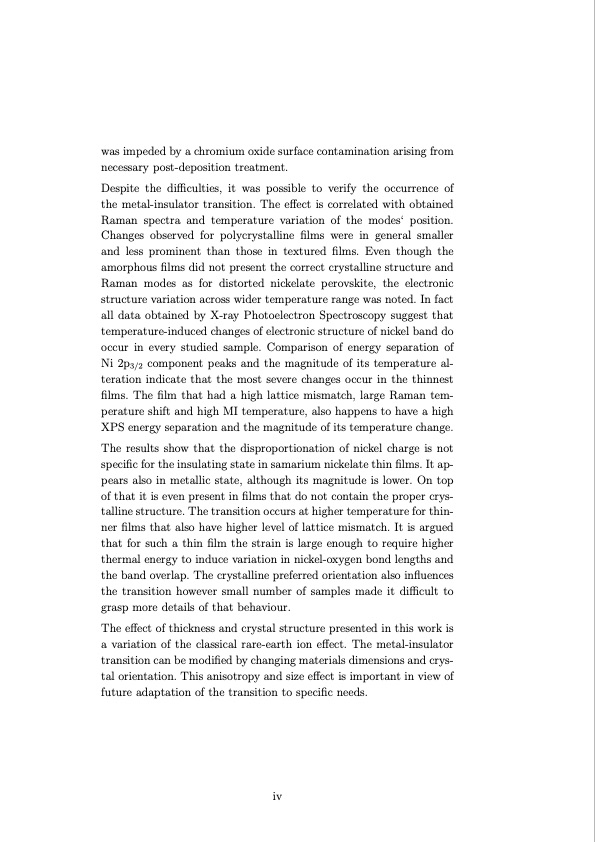
PDF Publication Title:
Text from PDF Page: 005
was impeded by a chromium oxide surface contamination arising from necessary post-deposition treatment. Despite the difficulties, it was possible to verify the occurrence of the metal-insulator transition. The effect is correlated with obtained Raman spectra and temperature variation of the modes‘ position. Changes observed for polycrystalline films were in general smaller and less prominent than those in textured films. Even though the amorphous films did not present the correct crystalline structure and Raman modes as for distorted nickelate perovskite, the electronic structure variation across wider temperature range was noted. In fact all data obtained by X-ray Photoelectron Spectroscopy suggest that temperature-induced changes of electronic structure of nickel band do occur in every studied sample. Comparison of energy separation of Ni 2p3/2 component peaks and the magnitude of its temperature al- teration indicate that the most severe changes occur in the thinnest films. The film that had a high lattice mismatch, large Raman tem- perature shift and high MI temperature, also happens to have a high XPS energy separation and the magnitude of its temperature change. The results show that the disproportionation of nickel charge is not specific for the insulating state in samarium nickelate thin films. It ap- pears also in metallic state, although its magnitude is lower. On top of that it is even present in films that do not contain the proper crys- talline structure. The transition occurs at higher temperature for thin- ner films that also have higher level of lattice mismatch. It is argued that for such a thin film the strain is large enough to require higher thermal energy to induce variation in nickel-oxygen bond lengths and the band overlap. The crystalline preferred orientation also influences the transition however small number of samples made it difficult to grasp more details of that behaviour. The effect of thickness and crystal structure presented in this work is a variation of the classical rare-earth ion effect. The metal-insulator transition can be modified by changing materials dimensions and crys- tal orientation. This anisotropy and size effect is important in view of future adaptation of the transition to specific needs. ivPDF Image | Investigation of metal-insulator transition in magnetron sputtered samarium nickelate thin films

PDF Search Title:
Investigation of metal-insulator transition in magnetron sputtered samarium nickelate thin filmsOriginal File Name Searched:
Bilewska_Investigation_of_metal_insulator_transition_in_magnetron_sputtered_samarium.pdfDIY PDF Search: Google It | Yahoo | Bing
Sulfur Deposition on Carbon Nanofibers using Supercritical CO2 Sulfur Deposition on Carbon Nanofibers using Supercritical CO2. Gamma sulfur also known as mother of pearl sulfur and nacreous sulfur... More Info
CO2 Organic Rankine Cycle Experimenter Platform The supercritical CO2 phase change system is both a heat pump and organic rankine cycle which can be used for those purposes and as a supercritical extractor for advanced subcritical and supercritical extraction technology. Uses include producing nanoparticles, precious metal CO2 extraction, lithium battery recycling, and other applications... More Info
| CONTACT TEL: 608-238-6001 Email: greg@infinityturbine.com | RSS | AMP |